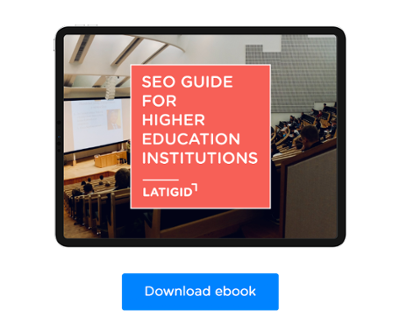
Welcome to our blog article, where we dive into the world of content marketing for higher education. In this journey, we'll uncover the strategies, insights and best practices that can enable educational institutions to create compelling and authentic content that not only captures the essence of their mission, but also resonates deeply with their target audience.
Key benefits of content marketing for higher education
Content marketing has emerged as a powerful tool for educational institutions, offering a multitude of compelling reasons why it should be an integral part of their marketing strategy. Here are some key advantages:
Enhanced brand visibility: Content marketing helps educational institutions increase their online presence. By consistently producing valuable and relevant content, you can improve your institution's visibility on search engines and social media, making it easier for prospective students and stakeholders to find you.
Establish thought leadership: Content marketing allows your institution to position itself as a thought leader in its field. By sharing expert insights, research findings, and educational resources, you can build a reputation for excellence and expertise.
Improved student recruitment: Engaging content can attract prospective students and help them make informed decisions about their education. By addressing common questions and concerns, you can guide potential students through the enrollment process.
Nurture relationships: Content marketing isn't just about attracting new students; it's also about maintaining and strengthening relationships with current students, alumni, faculty, and staff. Sharing success stories, campus news, and alumni achievements can foster a sense of community and loyalty.
Showcase campus life: Through content marketing, you can provide a glimpse into campus life, facilities, extracurricular activities, and student experiences. This can help students envision themselves as part of your institution's vibrant community.
Demonstrate diversity and inclusivity: Content marketing allows you to highlight your institution's commitment to diversity and inclusivity. Share stories and initiatives that showcase the diverse backgrounds and perspectives within your community.
Engage alumni and donors: Content marketing can be a powerful tool for alumni engagement and fundraising efforts. Share stories of alumni success, research breakthroughs, and philanthropic initiatives to inspire alumni to stay connected and support your institution.
Cost-effective marketing: Compared to traditional advertising methods, content marketing is often more cost-effective. It can reach a broader audience without the high costs associated with print advertising or paid media campaigns.
Analytics and data-driven insights: Content marketing allows you to track and measure the performance of your content campaigns. Analyzing metrics such as website traffic, engagement, and conversion rates provides valuable insights to refine your marketing strategies.
Adaptability: Content marketing is highly adaptable. You can tailor your content to different audience segments, academic programs, and goals, ensuring that your marketing efforts remain relevant and effective.
Long-term impact: High-quality content has a lasting impact. Once published, it continues to attract and engage audiences over time, providing long-term value for your institution.
Educational resource: Content marketing can serve as an educational resource for your target audience. By sharing informative content, you not only promote your institution but also contribute to the knowledge and growth of your audience.
Related article: How Content Marketing Can Improve Universities Visibility
High-fidelity content tips for higher education

Creating high-fidelity content for higher education requires a strategic approach that combines quality, relevance, and authenticity. Here are the steps to create content that resonates with your audience and represents your institution effectively:
Understand your audience
- Start by conducting thorough audience research to understand the demographics, interests, and needs of your target audience, including prospective students, current students, alumni, faculty, and stakeholders.
Define clear objectives
- Determine the specific goals you want to achieve with your content. Are you aiming to attract prospective students, engage current students, foster alumni connections, or achieve other objectives? Clear objectives will guide your content creation process.
Create a content strategy
- Develop a content strategy that outlines the types of content you'll create, the platforms you'll use, and the frequency of publication. Your strategy should align with your institution's mission and branding.
Quality research and information
- Content for higher education should be well-researched and accurate. Ensure that your information is up-to-date and cite reputable sources when necessary. High-quality content establishes your institution as a trusted source of knowledge.
Educational value
- Provide educational value in your content. Address common questions, offer insights into academic programs, share research findings, and provide practical advice that benefits your audience.
Engaging visuals
- Incorporate visually appealing elements, such as images, infographics, videos, and charts, to make your content more engaging and easier to digest. Visuals can enhance the overall quality of your content.
Use of multimedia
- Diversify your content with multimedia formats, including podcasts, webinars, and virtual tours. Different people prefer different types of content, so offering a variety can reach a broader audience.
Optimize for SEO
- Implement search engine optimization (SEO) best practices to improve the discoverability of your content. Use relevant keywords, optimize meta descriptions, and ensure your content is structured for search engines.
Consistency and regularity
- Maintain a consistent posting schedule to keep your audience engaged. Regularly updated content signals to search engines and your audience that your institution is active and relevant.
Engage and interact
- Encourage engagement by responding to comments and questions on your content. Foster a sense of community by involving your audience in discussions and polls related to higher education topics.
Measure and analyze
- Use analytics tools to track the performance of your content. Monitor metrics like website traffic, engagement rates, and conversion rates to assess the effectiveness of your content strategy.
Feedback and iteration
- Pay attention to feedback from your audience and adjust your content strategy accordingly. Continuously iterate and improve your content to meet evolving audience needs and preferences.
Compliance and accessibility
- Ensure that your content complies with accessibility guidelines, making it inclusive and usable for all individuals, including those with disabilities.
Promote and share
- Actively promote your content through various channels, including social media, email newsletters, and partnerships with other educational organizations. Share your content with influencers and relevant communities to expand your reach.
Creating high-fidelity content for higher education is an ongoing process that requires dedication and a deep understanding of your institution's unique value proposition. By following these steps and adapting your approach based on audience feedback and analytics, you can create content that resonates, educates, and engages your target audience effectively.
Related article: Increasing Student Enrollment: SEO Techniques for Universities
About LATIGID
We are a higher education marketing agency. We help you grow by increasing website traffic, generating more student leads, and closing those leads into enrollment. With a deep understanding of the latest industry trends and best practices, we are well equipped to help your institution grow.
If you are looking for a higher education marketing agency to partner with, check our page to see what we can do for you!
Download our SEO guide and learn how to build a strategy to optimize your Higher Education Institution's website





